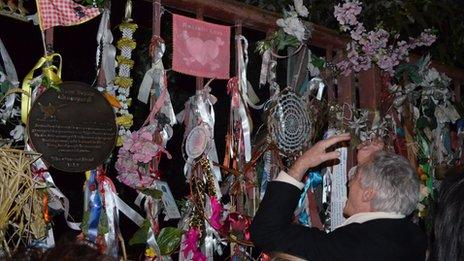Cross Bones graveyard: Remembering London’s outcasts
- Published

It is a crisp winter's night on an old, narrow London street and though some of the capital's top attractions are just a few hundred metres away, all is eerily quiet.
Half way along the dimly lit road, rusty iron gates stand, covered in hundreds of brightly coloured feathers, flowers and faded photos.
There is movement in the distance. Figures young and old descend upon the street, a few at a time. They carry candles, musical instruments and flasks of tea.
Redcross Way, near London Bridge, in south London, is a place of pilgrimage and this is the night of its monthly vigil.
On the other side of the gates lies a once-forgotten graveyard for the outcasts of society - called Cross Bones.
The bodies of 15,000 paupers and prostitutes are believed to have been buried there since late medieval times.
'Honorary outcast'
Then more than 150 years ago, the graveyard was shut down.
But when construction workers began to carve out the tunnels for the Jubilee line extension in the 1990s, they discovered dozens of skulls and bones.
"We've seen photos from the excavation that show skulls and bones packed together in a single area," says local playwright John Constable. "It's quite chilling."
This is a special night for him as he plans to perform the poem he wrote 15 years ago, about the discovery of the bones.
"The idea is everyone comes together as an honorary outcast and we celebrate this through our singing and poems and our creative work," says Mr Constable, 60, who has lived in Southwark for 26 years.
"This is to feel connected in the inner city and to feel in some small way we can influence the future."
Mr Constable was one of the founding members of Friends of Crossbones, who have held a vigil every month since 2004.
"In the early days there were just a few of us, but now we have 30 or 40 people," he says. "On exceptional occasions we've had 150 people."
'City's shadow'
He says the area is special because "with the City just over London Bridge, being where all the wealth was, this was in every sense in its shadow.
"It is where the City would dump everything it didn't want to have on that side - prisons, slaughter houses and brothels."
Cross Bones represents "ordinary Londoners - honest, hard working but very poor people who really built the city but are not generally remembered," he adds.
It was first known as "single women's burial ground", Mr Constable says, where "local prostitutes - known as the Winchester Geese - were believed to have been buried ".
But it was also a burial ground for children.
"Up to half of the people buried there were children, which exemplifies the incredibly high infant mortality there was in that area," he says.
One of tonight's attendees, Jenn Cooper, from Stockwell, believes her ancestors may have had connections to the graveyard.
"My granddad was a local costermonger," she says. "He may have known some of the people who were buried here."
Development plans
Friends of Cross Bones have something else in common - they are campaigning to protect the graveyard.
Cross Bones sits on land that is part of a derelict site owned by Transport for London (TfL), which it has had plans to redevelop for a number of years.
TfL's head of property Anthony Bickmore said: "The future use of the site would be a comprehensive redevelopment of the whole site and we have been working with the local community to sensitively address local concerns.
"We remain committed to working with the community to reach a satisfactory conclusion."
Mr Constable said Friends of Cross Bones "accept there will be a development" but stresses it should be on the "northern part of the site", rather than where the graveyard sits.
"Any development should... also look to make it open to the public as a garden of remembrance," he adds.
Meanwhile, this vigil will also remember those who have died more recently.
Dave Fisher is known by his friends as Dave 500, as he was the 500th person to sign the petition to protect the site.
Mr Fisher, whose family have lived locally in Bermondsey since the 19th Century, has been attending the vigils for the past two years.
"I lost my son Jason just over a year ago," he says. "I sometimes give a little speech for him."
Mr Constable says: "It becomes a many-layered thing that we're doing.
"Anyone who feels an outsider is welcome. Sex workers are welcome but so are office workers."
- Published31 October 2010